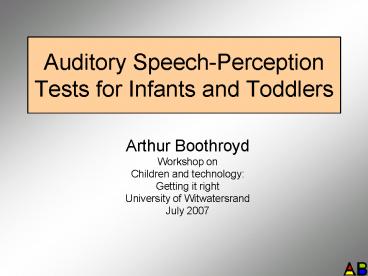Auditory SpeechPerception Tests for Infants and Toddlers PowerPoint PPT Presentation
1 / 15
Title: Auditory SpeechPerception Tests for Infants and Toddlers
1
Auditory Speech-Perception Tests for Infants and
Toddlers
- Arthur Boothroyd
- Workshop on
- Children and technology
- Getting it right
- University of Witwatersrand
- July 2007
2
Acknowledgements
- Laurie Eisenberg Ph.D. (PI)
- Amy Martinez
- Funded by NIH grant DC006238 to the House Ear
Institute
3
Why test auditory speech-perception capacity in
young children with hearing loss?
- Describe and quantify
- Inform sensory decisions
- Evaluate sensory outcome
- Inform habilitative decisions
- Evaluate habilitative progress and outcome
- Advance evidence-based practice
4
The challenge
What the aid/implant/cochlea/auditory
nerveprovide
Auditory capacity
Listening experience, maturation
How the brain,uses it
Auditory skills
Phonological, lexical, syntactic development
Merging auditoryskills and spokenlanguage
Speech perception skills
Interest, relevance, social and cognitive
status Tester rapport/skill
Doing what youwant, if he can, and if he wants
to
Test performance
5
CAPACITY?
PERFORMANCE?
Nittrouer and Boothroyd, unpublished data
6
Duration of use effect in implanted children
CAPACITY?
PERFORMANCE?
7
BATIT
Battery of Auditory speech-perception Tests
for Infants and Toddlers
8
Goals
- Performance vs. age (group individ.)
- Constant stimulus set
- Constant perceptual task(detection of phonemic
contrast) - Variable response task(to suit maturity and
interest) - Performance ? confidence (that child hears
contrasts)
9
BATIT the tests
NAME Response task AgeVRASPAC Conditi
oned head turn 6 - 18 months PLAYSPAC Co-operativ
e play 2.5 - 5 years OLIMSPAC Imitation 3
years (Evaluated by 8AFC) BUTTONSPAC Button
Press 3 years (To complete
jigsaw)VIDSPAC Button Press 4 years (in
video-game) FCSPAC 8AFC 6 years
10
Normally hearing children
0
1
2
3
4
5
6
7
Age in years
11
Electro-physiologyto therescue?
12
The Acoustic Change Complex (ACC) (experimental)
ooee ooee ooee ooee ooee ooee ooee
ooee...
13
Group mean waveforms
x
x
?
\/
\/
\/
\/
From Ostroff (1999) PhD Dissertation CUNY
14
32 Hz
15
Summary
- Auditory speech-perception capacity detection
and differentiation of acoustic speech patterns - Many reasons to measure in young HI
- But must be inferred from performance
- - which also reflects non-auditory factors
- BATIT helps minimize these factors
- Perhaps EP can be the ultimate validation

